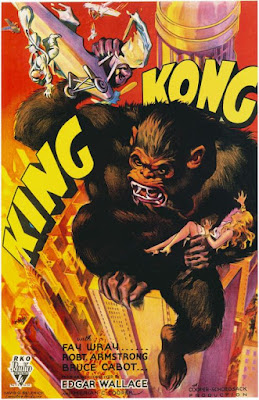King Kong (1933)
Director: Merian C. Cooper, Ernest B. Schoedsack
Stars: Fay Wray, Robert Armstrong, Bruce Cabot
Runtime: 100 minutes
Synopsis: A film crew goes to a tropical island for an exotic location shoot and discovers a colossal ape who takes a shine to their female blonde star. He is then captured and brought back to New York City for public exhibition.
Verdict: When a group of white American men set foot on a remote island in the middle of nowhere to make it the main location of their newest film, they are greeted by its local tribe and the giant ape they worship. Kong is unlike anything they’ve ever seen, he’s a colossal beast that is more intimidating than dangerous, an impressive animal whose most striking characteristic is his capability of loving a human being. But in true American fashion, the crew in question only sees him as a potential investment, an attraction that will draw hundreds of thousands of people. To them, he’s just a giant green bill.
If it’s not already obvious, “King Kong” is far more than the grandfather of monster movies. Don’t get me wrong, the legacy it left behind is one that deserves to be celebrated and applauded, but what drew me the most about it is the way it uses that concept to comment on America’s darkest chapter. Much like the millions of slaves that were still in captivity less than a century prior to the film’s release, Kong was forcibly taken from his home with the sole purpose of enriching its white captors. In other words, the true monster in this classic is certainly not the titular character, but rather a substantial representation of man’s ugliest side.
Released in 1933, the film was ahead of its time in various ways, but it also feels dated in many others. As was the norm in Hollywood at the time, “King Kong” has countless blatant sexist and racist connotations, the latter being most notably materialized in the representation of an Asian character that is part of the expedition. The dialogue isn’t always convincing either, especially the lines written for Robert Armstrong’s character which, unfortunately, make it difficult to take his character as seriously as the filmmakers want us to. That criticism extends also to the movie’s goofy visual effects which may have been revolutionary at the time and still somewhat hold up to this day due to their charm, but don’t mix well with the narrative’s much more serious tone.
The original “King Kong” is still an iconic feature that every film lover must experience at least once in their lives. Without it, Cinema as we know it today wouldn’t be the same. It also gave us one of the most iconic lines of all time in “It was Beauty killed the Beast” which, in retrospect, couldn’t be more inaccurate as his fate was met due to man’s greed.
FINAL GRADE: 8/10

Comments
Post a Comment